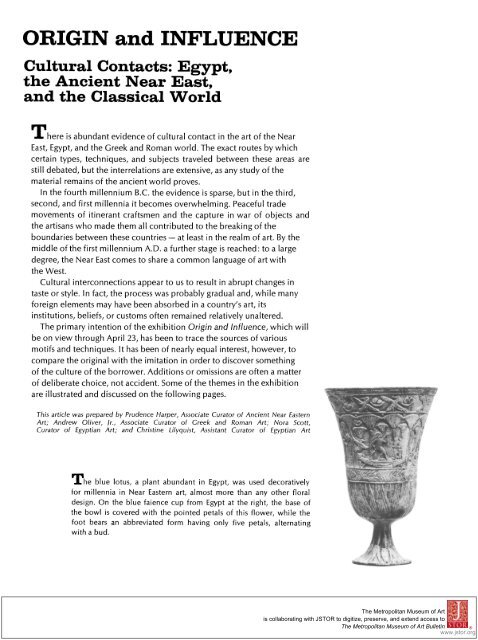The Metropolitan Museum of Art Bulletin, v. 29, no. 7 (March, 1971)
The Metropolitan Museum of Art Bulletin, v. 29, no. 7 (March, 1971)
The Metropolitan Museum of Art Bulletin, v. 29, no. 7 (March, 1971)
You also want an ePaper? Increase the reach of your titles
YUMPU automatically turns print PDFs into web optimized ePapers that Google loves.
ORIGIN and INFLUENCE<br />
Cultural Contacts: Egypt,<br />
the Ancient Near East,<br />
and the Classical World<br />
T here is abundant evidence <strong>of</strong> cultural contact in the art <strong>of</strong> the Near<br />
East, Egypt, and the Greek and Roman world. <strong>The</strong> exact routes by which<br />
certain types, techniques, and subjects traveled between these areas are<br />
still debated, but the interrelations are extensive, as any study <strong>of</strong> the<br />
material remains <strong>of</strong> the ancient world proves.<br />
In the fourth millennium B.C. the evidence is sparse, but in the third,<br />
second, and first millennia it becomes overwhelming. Peaceful trade<br />
movements <strong>of</strong> itinerant craftsmen and the capture in war <strong>of</strong> objects and<br />
the artisans who made them all contributed to the breaking <strong>of</strong> the<br />
boundaries between these countries - at least in the realm <strong>of</strong> art. By the<br />
middle <strong>of</strong> the first millennium A.D. a further stage is reached: to a large<br />
degree, the Near East comes to share a common language <strong>of</strong> art with<br />
the West.<br />
Cultural interconnections appear to us to result in abrupt changes in<br />
taste or style. In fact, the process was probably gradual and, while many<br />
foreign elements may have been absorbed in a country's art, its<br />
institutions, beliefs, or customs <strong>of</strong>ten remained relatively unaltered.<br />
<strong>The</strong> primary intention <strong>of</strong> the exhibition Origin and Influence, which will<br />
be on view through April 23, has been to trace the sources <strong>of</strong> various<br />
motifs and techniques. It has been <strong>of</strong> nearly equal interest, however, to<br />
compare the original with the imitation in order to discover something<br />
<strong>of</strong> the culture <strong>of</strong> the borrower. Additions or omissions are <strong>of</strong>ten a matter<br />
<strong>of</strong> deliberate choice, <strong>no</strong>t accident. Some <strong>of</strong> the themes in the exhibition<br />
are illustrated and discussed on the following pages.<br />
This article was prepared by Prudence Harper, Associate Curator <strong>of</strong> Ancient Near Eastern<br />
<strong>Art</strong>; Andrew Oliver, Jr., Associate Curator <strong>of</strong> Greek and Roman <strong>Art</strong>; Nora Scott,<br />
Curator <strong>of</strong> Egyptian <strong>Art</strong>; and Christine Lilyquist, Assistant Curator <strong>of</strong> Egyptian <strong>Art</strong><br />
<strong>The</strong> blue lotus, a plant abundant in Egypt, was used decoratively<br />
for millennia in Near Eastern art, almost more than any other floral<br />
design. On the blue faience cup from Egypt at the right, the base <strong>of</strong><br />
the bowl is covered with the pointed petals <strong>of</strong> this flower, while the<br />
foot bears an abbreviated form having only five petals, alternating<br />
with a bud.<br />
<strong>The</strong> <strong>Metropolitan</strong> <strong>Museum</strong> <strong>of</strong> <strong>Art</strong><br />
is collaborating with JSTOR to digitize, preserve, and extend access to<br />
<strong>The</strong> <strong>Metropolitan</strong> <strong>Museum</strong> <strong>of</strong> <strong>Art</strong> <strong>Bulletin</strong> ®<br />
www.jstor.org

















